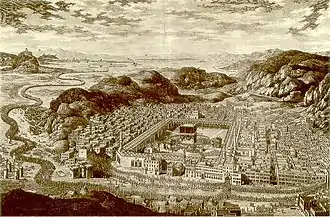| Capture of Mecca | |||||||
|---|---|---|---|---|---|---|---|
| Part of the Ottoman–Saudi War | |||||||
 View of Mecca | |||||||
| |||||||
| Belligerents | |||||||
|
|
| ||||||
| Commanders and leaders | |||||||
|
|
| ||||||
| Strength | |||||||
| 1,500 men | Unknown | ||||||
| Casualties and losses | |||||||
| 32 | 950 | ||||||
The capture of Mecca in 1813 (Turkish: Mekke'nin Osmanlıya Dönüşü) happened several days after the capture of Jeddah during the Ottoman–Saudi War.
Capture
Mustafa Bey, the brother-in-law of Muhammad Ali Pasha advanced after taking Medina with a force of a thousand cavalry and five hundred infantry. The Meccan Shariff Ghalib ibn Musa'id, who wanted to get rid of Saudi rule, preferred the Ottoman rule. He sent messages to Mustafa Bey, inviting him to his towns. The Saudi General, Uthman Al-Medhyafi, met the Ottoman forces but found himself not strong enough to offer a battle. He retreated towards Taif. A few hours before Mustafa entered Mecca victoriously in January 1813, he proclaimed amnesty to the inhabitants of Mecca. Ghalib now joined his forces, around a thousand Arabs and black slaves.[1][2][3]
Aftermath
After the capture of Mecca and Jeddah, news soon reached Cairo, and celebrations were held for five days. After the capture, the Ottoman forces captured Taif on 29 January after some skirmishing.[4][5]
References
- ↑ Journal of the Asiatic Society of Bombay, p. 325
- ↑ John Lewis Burckhardt, Notes on the Bedouins and Wahábys, p. 356
- ↑ Abd al Rahman al Rafai, The era of Muhammad Ali, p. 130
- ↑ Abd al Rahman al Rafai, p. 130
- ↑ John Lewis Burckhardt, p. 357